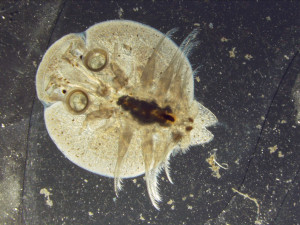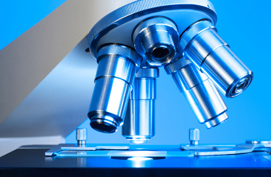
As hard as we all try, we can never keep koi and goldfish healthy 100% of the time. They are living animals, and animals get sick. It happens, even to the most experienced breeders, dealers and hobbyists in the world.
General Health Info
Quarantine
We recommend that you quarantine all new fish for at least ten days before selling them. Any disease issues brought on by the stress of shipping will become apparent within 10 days. And remember, if your fish do become sick, you’re covered by our 30 Day No Questions Asked Guarantee.
The Biological Filter Cycle
“The Cycle” refers to the sequence of events that take place in all new biological filters during the first few weeks of operation. Understanding the cycle process is crucial to maintaining a stable and healthy environment in your pond or tank.
When a brand new filter system is set up, the filter media inside of that system has no way to filter waste out of the water. Bacteria need to grow on the filter media. The bacteria, not the media itself, is what actually removes waste from the water.
The waste is removed by a family of beneficial bacteria called Nitrosomonus. As fish produce waste, levels of a toxic chemical called ammonia build in the water. Once ammonia is present, Nitrosomonus will begin to grow on the media, feeding off of the ammonia in the water and converting it to nitrite, another toxic chemical.
As nitrite becomes present, a second kind of bacteria, Nitrobacter, will begin to grow on the media and feed on the nitrite. The nitrite is converted into nitrate, a relatively harmless chemical.
TO CORRECTLY CYCLE YOUR FILTER
When fish are first introduced into a new filter system, the ammonia levels will spike quickly. During this period, keep your stocking density and feeding low, and do 20% water changes regularly. As the ammonia levels decrease, the nitrite will increase. Continue to keep your stocking density low and make regular water changes. Also, add salt at 3-4 pounds per 100 gallons of water, to reduce the toxicity of the nitrites.When both the ammonia and nitrite levels decrease to near zero, your filter system is fully cycled. You can now slowly increase your stocking densities. To speed up the process, add filter media from a cycled filter to your existing filter.
Water Quality
In order to succeed at keeping Koi and Goldfish, you must ensure that you are providing the fish with the best possible water conditions. Additionally, educating your customers about water quality can go a long way toward keeping their fish alive, and keeping them happy.
Too often, disease and death among Koi and Goldfish is a result of bad water quality. The following are water quality parameters that you must adhere to in order to be successful.
Removing Toxic Chemicals
Chlorine and chloramines are commonly used to disinfect public water supplies. Both are lethal to fish. They can be eliminated easily with commercial water conditioners, designed to neutralize poisonous compounds present in tap water.
Temperature
Temperature should be between 65 and 85 degrees. Goldfish and koi will thrive below 65 degrees, but disease treatment is much more effective at higher temperatures, where the fish’s immune system is functioning better. Be sure to keep your holding facilities in the shade if possible to avoid high temperatures.
Dissolved Oxygen
Fish need oxygen in the water to survive. A lightly stocked pond may not need additional aeration. However, if you have more than just a few fish in your pond or holding tank, additional aeration may be needed. You can purchase air blowers, air stones, or paddle aerators designed for this purpose.
If the water is low of dissolved oxygen, the fish will come to the top and stick their noses out of the water, seeming to gasp for air. Inexpensive oxygen test kits can are available throughout the industry. Levels need to be above 6 ppm at all times.
pH
pH is the measurement of hydrogen ions in your water. It is vitally important to continually monitor your pH level, attempting to maintain a pH of 7.9.
The lower your pH is below 7.9, the more likely you are to suffer a pH crash, resulting in severe stress to your fish. To increase pH, add sodium bicarbonate (baking soda) @ 1 teaspoon per 10 gallons until the desired level is reached.
A higher pH alone is not harmful. However, a combination of high pH and ammonia in the water is a deadly combination. Lowering pH can be difficult. Adding peat or vinegar is somewhat effective.
Ammonia
Ammonia comes from fish waste and decomposition of uneaten food. Ammonia levels will quickly rise to lethal levels in a system with new or uncycled filters.
Levels need to be maintained as close to 0 ppm as possible. If levels are consistently above 0.5 ppm, you need to decrease stocking density and feeding, and/or increase filtration.
A combination of high pH and high ammonia is especially dangerous, because with each 1 point increase in pH (for example from pH 7 to pH 8) the ammonia present becomes 10 times more toxic.
You cannot smell or see high levels of ammonia. You MUST use test kits.
Nitrite
Bacteria in your filter system consume ammonia. Nitrite, a toxic byproduct of this process, must also be monitored. Nitrite accumulation will quickly kill fish in a system without fully cycled biofilters.
An ideal nitrite level is 0 ppm. Anything above 0.15 ppm is stressful to fish and can cause disease. To reduce high nitrite levels, increase your water changes and filtration, and decrease your feeding and stock density. Additionally, you can add uniodized salt at a rate of 3 pound per 100 gallons to decrease the toxicity of nitrite.
Disease and Infections
Bacterial Infections
It is important to remember that pathogenic bacteria are always present in our water and on our fish. They are a problem only when the fish are weakened by poor water quality or parasite infestations. So, before attempting to treat a bacterial infection, be sure that you correct any underlying problems first. Symptoms can include fin and tail erosion and fraying, redness of the tail, pectoral or anal fins, and red open sores (ulcer disease).
The most effective remedy for most bacterial infections is feeding medicated food containing tetracycline, romet, or oxolinic acid for 10-14 days. Medicated food was previously available for retail purchase, but has since been removed from the market by federal regulations. Directions and guidelines for making your own medicated food can be found online.
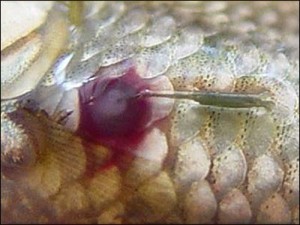
Anchorworm (Lernea)
Anchorworms resemble a short piece of thread coming from beneath a single scale. Koi infected with Anchorworms very often develop ulcer sores due to the damage caused by the worms as they bury into the flesh of the fish. Be aware that anchor worms will not disappear immediately. The treatment may take a week or longer, according to the water temperature.
Use Dimilin to treat.
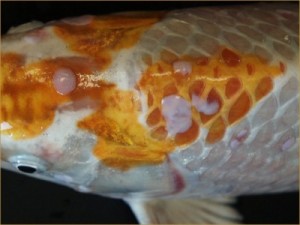
Carp Pox Virus
Is an unsightly but relatively harmless virus seen occasionally on koi. It has a waxy white appearance. It’s mostly seen in colder water temperatures and will many times disappear as the water warms.

Chilodonella
Like costia, chilodonella are microscopic. They are usually present in colder water (40-50 degrees). Symptoms are similar to those caused by costia.
Use Salt Bath, Salt Dip or Potassium Permanganate to treat.
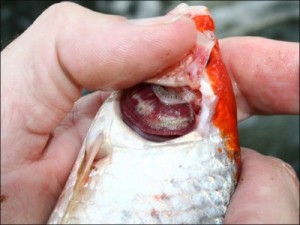
Columnaris (Flexibacter columnaris) Disease
Columnaris (Flexibacter columnaris) Disease is another bacterial infection. The primary symptom is white tufts that develop around the mouth and spread to the body and fins, often leading to ulcers and a thin appearance.
Often mistaken for a fungal infection because of its mold-like lesions, Columnaris is a common bacterial infection in cultured fish, particularly livebearing fish and catfish. Its name is derived from columnar shaped bacteria, which are present in virtually all pond environments.
The bacteria are most likely to infect fish that have been stressed by such conditions as poor water quality, inadequate diet, or handling and shipping. Columnaris can enter the fish through the gills, mouth, or via small wounds on the skin. The disease is highly contagious and may be spread through contaminated nets, specimen containers, and even food.
Treatment with anti bacterial medicine is usually effective.
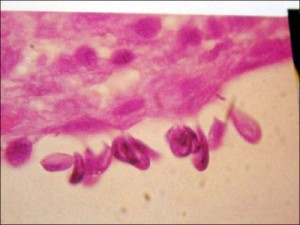
Costia
Costia are microscopic parasites that attack the skin and/or gills of the fish. Symptoms include loss of appetite, listlessness, flashing (rubbing their sides against the pond bottom), and excess slime production.
Costia normally only affects fish that have already been debilitated by some other cause, and can often be seen on Koi as a secondary parasite.
Costia is one of the many fish diseases that are caused by protozoa. It is a somewhat rare disease that is relatively easy to cure if your fish becomes infected by it. There are several treatments for this disease but it is of course preferable to prevent the protozoa from ever infecting you fish by keeping your facilities clean and your fish healthy and well fed, while at the same time doing what is possible to avoid introducing diseases and parasites into the pond.

Dropsy
Raised scales (rather like a pine cone) and eyes standing out from the head. A sign of a number of conditions, may be congenital heart or kidney failure or an internal bacterial infection.
Bacterial dropsy is infectious so treat with an anti bacterial remedy and if possible isolate affected Koi.
Fish Lice (Argulus)
Fish lice are sometimes mistaken for a small patch of green algae on the fish. After looking closer, you will see that it is a round “bug” that is a little larger than a pencil lead. As with anchor worms, fish lice make little holes in the fish, making them vulnerable to bacterial infections.
Treat with Dimilin.

Flukes (Gyrodactylus and Dactylogyrus)
Flukes are the most common parasite found on koi and goldfish. High numbers can cause serious damage. Symptoms include flashing (rubbing their sides against the pond bottom), gasping at the surface, and frayed fins. Most cases of ulcer disease are preceded by fluke infestations.
Treatment options for flukes are different for koi than they are for goldfish. For goldfish, treat with Praziquantel or Potassium Permanganate. For Koi treat with Supaverm or Potassium Permanganate.

Ich (Whitespot)
Ich is one of the most common and widespread of all fish diseases. It is characterized by tiny white spots the size of coarse sand. Its microscopic stage is round with a horseshoe shaped nucleus. Symptoms may appear before you see the white spots. They include flashing (rubbing their sides against the pond bottom), lethargy, and loss of appetite.
The treatment of choice for ich is salt for 10-21 days, depending on the water temperature. Ich takes longer to clear in colder water. Use the Salt Bath treatment listed below.
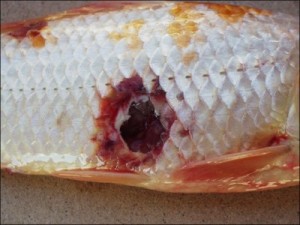
Ulcer Disease
Ulcer disease is a particularly destructive bacterial disease. Seen on koi and goldfish, it starts out as a red or white pimple and quickly widens into a large hole or ulcer. It can advance all the way into the muscle of the fish. It is very important to catch this disease in its earliest stages.
Anchorworms, fish lice, and flukes can all contribute to ulcer disease. Keeping your fish clear of these parasites is very important. Keep affected fish in salted water and feed medicated food. The bath treatment Tricide-Neo can help as well. Medicated food and Tricide-Neo can be found at Koi dealers and dry goods retailers. Valuable fish can warrant antibiotic injections. Contact an experienced veterinarian for assistance.

Trichodina
Another microscopic parasite, trichodina is easily identifiable. It resembles a wagon wheel. Fish infected with trichodina often develop a gray film over the body in response to the infestation. Other symptoms include flashing (rubbing their sides against the pond bottom), lethargy, and hanging at the surface.
Treat with Potassium Permanganate or Salt Dip.
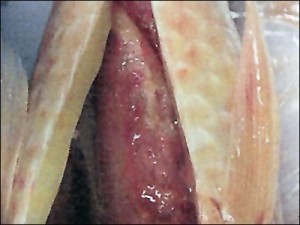
Koi Herpes Virus (KHV)
Is a very contagious, damaging and deadly disease for koi, many times causing up to 90% loss in just a few days. Symptoms can include respiratory distress, hyperactivity, loss of coordination, and severe gill necrosis.
It’s usually seen when the water temperature is between 70 and 80 degrees. As with most viral diseases there is no known cure. Some people have had success with heat treatment to 86F, but the carrier state of the survivors is currently unknown.
Goldfish are unaffected.
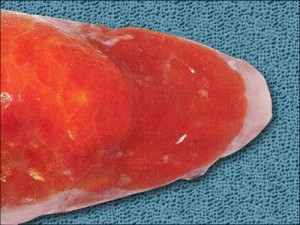
Spring Viremia of Carp (SVC)
Like the name suggests, SVC in seen only in the spring as pond temperatures are rising. It’s usually seen between 40 and 60 degrees Fahrenheit.
This virus is much less damaging than KHV and currently is very rare in the US. SVC produces symptoms typical of those seen with many infections and can include dropsy, hemorrhages and/ or darkening of the skin.
SVC is classified as a “reportable” disease, so a confirmed diagnosis can lead to heavy handed federal government involvement.
Treatments
WARNING: THE MEDICATIONS LISTED HERE ARE SAFE WHEN HANDLED PROPERLY. USE A DUST MASK, RUBBER GLOVES, AND SAFETY GLASSES WHEN HANDLING THESE CHEMICALS.
Treatment 1 – Salt Dip
Add salt to water at 10 tablespoons per gallon or 5 pounds per 25 gallons. Place fish in this solution for ninety seconds. The fish will turn white and roll over like it’s dying, but will quickly recover when returned to fresh water. This will quickly remove any microscopic parasites.
Treatment #2 – Salt Bath
We maintain salt in our holding facilities at 0.3%. This is obtained by adding 3 teaspoons per gallon or 25 pounds of non-iodized salt per 1,000 gallons over a 48 hour period. Some Costia strains can require up to .6% to eradicate. An accurate digital salt meter can be purchased for under $80 at Most Koi dealers and dry goods retailers.
Treatment #3 – Potassium Permanganate
Potassium permanganate is effective against all of the microscopic parasites listed above except ich. If you suspect that your fish may have parasites, but you do not have access to a microscope to confirm your suspicions, potassium should be your first choice for treatment.
It is somewhat more risky than salt, but only when you fail to measure your pond volume and dosages accurately. Potassium will turn the water purple or pink when first added to the tank or pond. It will eventually turn brown, according to the amount of dissolved organics in the water.
A 25% to 50% water change is recommended before beginning the treatment. Bypass the filter, ensure adequate aeration, and add potassium to the water at 6 grams (1 level teaspoon) per 800 gallons. In large systems, dissolve the crystals in warm water and distribute evenly around the pond or tank. Note the color of the water by submerging a white saucer 2-3 inches below the surface. If the color changes from purple/pink to brown/amber in less than 1 hour, redose at 1 teaspoon per 800 gallons. If the initial color change comes after 1 hour has elapsed, retreat at 1/2 teaspoon per 800 gallons.
Monitor the color of the water for the next 10 hours. Whenever the color is brown, add more potassium at 1/2 teaspoon per 800 gallons. The key for effective treatment with potassium is to maintain the pink color in the water for 10 hours. After 10 hours, do another 50% water change or add dechlorinators to neutralize the potassium.
Repeat the treatment in 3-4 days to ensure eradication of the parasites.
The treatment regimen described here is excerpted from Dr. Eric Johnson’s excellent book “Koi Health and Disease”. It contains more detailed information concerning the use of potassium and other fisheries chemicals used to treat goldfish and koi.
Treatment #4 – Dimilin
Dimilin is sold under the brand names Anchors Away by Jungle Labs or Express IDI for the treatment of anchor worms and fish lice. Use as directed.
Treatment #5 – Praziquantel
Prazinquantel (brand name Prazi Pond) Effective to treat flukes on goldfish and Koi.
Treatment #6 – Supaverm
Supaverm is the treatment of choice for flukes on koi. WARNING: DO NOT USE SUPAVERM ON GOLDFISH. IT WILL KILL THEM.

